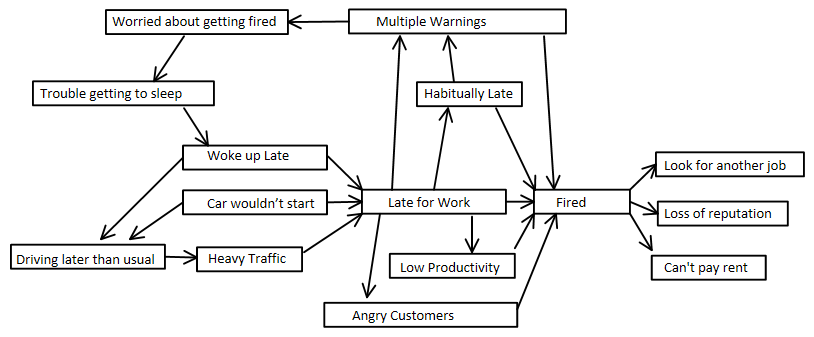Systems Thinking describes a way of understanding the world around us, of thinking about how things work and ‘seeing’ things in a particular way. People who use Systems Thinking often use diagrams to model their understanding, not only of the elements that make up a whole, but also of the interactions between these elements.
“The essence of systems thinking and practice is in ‘seeing’ the world in a particular way, because how you ‘see’ things affects the way you approach situations or undertake specific tasks.”
Systems Thinking and Practice, Open University
Modelling the cause-and-effect relationship between different parts of a whole (aka a “system”) highlights how each part affects, and is affected by, all the other parts. These relationships are often not simply linear 1:1 relationships, but are multi-factorial, complex, looping inter-relationships that are difficult to understand using mental power alone.
For example, if I’m late for work, I could get fired. There is a cause-and-effect relationship here:
But reality is a little more complicated than that. What caused me to be late for work? Perhaps it was a combination of things – and it’s unlikely that getting to work late on a single day would be enough to get me fired. In addition, getting fired causes its own set of effects…
… and so on. The car wouldn’t start because X, Y, Z. Loss of reputation causes A, B, C which makes it harder to find a new job, which makes it harder to pay the rent. You get the idea.
The only limits to the extent of modelling the world around us are:
– Time and Imagination to identify new cause-and-effect relationships, or
– The usefulness of the model
Great theory, but how is this relevant to business?
Relevance to business
Systems models can aid understanding of the complex environment that businesses operate within. The models can simplify the confusion and seeming disarray of business events and clarify the cause-and-effect relationships which really matter to a business’ performance.
We have all observed projects, implemented with the best intent, produce less-than-desirable results – or worse, opposite to their intended effect. And the reason is that in a complex, multi-factorial environment, people often fail to identify all the critical levers to success and focus on only one or two, leaving the rest to chance. Not a great way to get high performing, sustainable business results!
